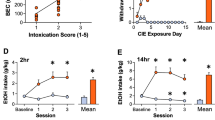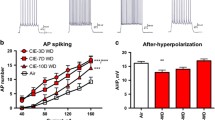Abstract
Intermittent ethanol consumption changes the neuronal activity of the orbitofrontal cortex (OFC) in rodents, which has been attributed to important participation in the development of addiction, particularly alcoholism. The OFC participates in gustatory sensory integration. However, it is unknown whether this region can encode chemosensory elements of oral ethanol administration independently of the consumption movement (orofacial motor response) when administered for the first time (naïve mice). To answer this question, we used a sedated mouse model and a temporary analysis protocol to register extracellular neuronal responses during the oral administration of ethanol. Our results show an increase in neuronal frequency (in the first 500 ms) when low (0.6, 1, and 2.1 M) and high (3.2, 4.3, and 8.6 M) concentrations of ethanol are orally administered. The modulatory effect of ethanol was observed from low and high concentrations and differed from the tastants. There was consistent neuronal activity independent of the concentration of ethanol. Our results demonstrate a sensory representation of oral ethanol stimulation in the OFC neurons of naïve mice under sedation.





Similar content being viewed by others
Data availability statement
The datasets generated during and/or analyzed during the current study are available from the corresponding author on reasonable request.
References
Accolla R, Bathellier B, Petersen CC, Carleton A (2007) Differential spatial representation of taste modalities in the rat gustatory cortex. J Neurosci 27(6):1396–1404
Banerjee A, Parente G, Teutsch J, Lewis C, Voigt FF, Helmchen F (2020) Value-guided remapping of sensory cortex by lateral orbitofrontal cortex. Nature 585(7824):245–250
Blizard DA (2007) Sweet and bitter taste of ethanol in C57BL/6J and DBA2/J mouse strains. Behav Genet 37(1):146–159
Cannady R, Nimitvilai-Roberts S, Jennings SD, Woodward JJ, Mulholland PJ (2020) Distinct region- and time-dependent functional cortical adaptations in C57BL/6J mice after short and prolonged alcohol drinking. eNeuro 7(3):ENEURO.0077-20.2020. https://doi.org/10.1523/ENEURO.0077-20.2020
Churchland MM, Yu BM, Cunningham JP, Sugrue LP, Cohen MR, Corrado GS, Newsome WT, Clark AM, Hosseini P, Scott BB, Bradley DC, Smith MA, Kohn A, Movshon JA, Armstrong KM, Moore T, Chang SW, Snyder LH, Lisberger SG, Priebe NJ, Finn IM, Ferster D, Ryu SI, Santhanam G, Sahani M, Shenoy KV (2010) Stimulus onset quenches neural variability: a widespread cortical phenomenon. Nat Neurosci 13(3):369–378
den Hartog C, Zamudio-Bulcock P, Nimitvilai S, Gilstrap M, Eaton B, Fedarovich H, Motts A, Woodward JJ (2016) Inactivation of the lateral orbitofrontal cortex increases drinking in ethanol-dependent but not non-dependent mice. Neuropharmacology 107:451–459
Ellingson JM, Silbaugh BC, Brasser SM (2009) Reduced oral ethanol avoidance in mice lacking transient receptor potential channel vanilloid receptor 1. Behav Genet 39(1):62–72
Fonseca E, de Lafuente V, Simon SA, Gutierrez R (2018) Sucrose intensity coding and decision-making in rat gustatory cortices. Elife 7:e41152
Frank S, Kullmann S, Veit R (2013) Food related processes in the insular cortex. Front Hum Neurosci 7:499
Gutierrez R, Carmena JM, Nicolelis MA, Simon SA (2006) Orbitofrontal ensemble activity monitors licking and distinguishes among natural rewards. J Neurophysiol 95(1):119–133
Jones LM, Fontanini A, Katz DB (2006) Gustatory processing: a dynamic systems approach. Curr Opin Neurobiol 16(4):420–428
Katz DB (2005) The many flavors of temporal coding in gustatory cortex. Chem Senses 30(Suppl 1):i80-81
Katz DB, Simon SA, Nicolelis MA (2001) Dynamic and multimodal responses of gustatory cortical neurons in awake rats. J Neurosci 21(12):4478–4489
Kobayashi T, Ikeda K, Kojima H, Niki H, Yano R, Yoshioka T, Kumanishi T (1999) Ethanol opens G-protein-activated inwardly rectifying K+ channels. Nat Neurosci 2(12):1091–1097
Levitan D, Lin JY, Wachutka J, Mukherjee N, Nelson SB, Katz DB (2019) Single and population coding of taste in the gustatory cortex of awake mice. J Neurophysiol 122(4):1342–1356
Luo L, Zhang X, Xiang T, Yuan JL, Tang JY, Yu Q (2019) Propofol inhibited the excitability of pyramidal neurons in the orbitofrontal cortex by influencing the delayed rectifier K+ channels and gamma-aminobutyric acid type A receptors. NeuroReport 30(2):102–107
Mukherjee N, Wachutka J, Katz DB (2019) Impact of precisely-timed inhibition of gustatory cortex on taste behavior depends on single-trial ensemble dynamics. Elife 8:e45968
Pascoli V, Hiver A, Van Zessen R, Loureiro M, Achargui R, Harada M, Flakowski J, Luscher C (2018) Stochastic synaptic plasticity underlying compulsion in a model of addiction. Nature 564(7736):366–371
Quiroga RQ, Nadasdy Z, Ben-Shaul Y (2004) Unsupervised spike detection and sorting with wavelets and superparamagnetic clustering. Neural Comput 16(8):1661–1687
Renteria R, Baltz ET, Gremel CM (2018) Chronic alcohol exposure disrupts top-down control over basal ganglia action selection to produce habits. Nat Commun 9(1):211
Rolls ET (2004) Convergence of sensory systems in the orbitofrontal cortex in primates and brain design for emotion. Anat Rec A Discov Mol Cell Evol Biol 281(1):1212–1225
Sadacca BF, Rothwax JT, Katz DB (2012) Sodium concentration coding gives way to evaluative coding in cortex and amygdala. J Neurosci 32(29):9999–10011
Saito M, Toyoda H, Kawakami S, Sato H, Bae YC, Kang Y (2012a) Capsaicin induces theta-band synchronization between gustatory and autonomic insular cortices. J Neurosci 32(39):13470–13487. https://doi.org/10.1523/JNEUROSCI.5906-11.2012
Scinska A, Koros E, Habrat B, Kukwa A, Kostowski W, Bienkowski P (2000) Bitter and sweet components of ethanol taste in humans. Drug Alcohol Depend 60(2):199–206
Small DM, Bender G, Veldhuizen MG, Rudenga K, Nachtigal D, Felsted J (2007) The role of the human orbitofrontal cortex in taste and flavor processing. Ann N Y Acad Sci 1121:136–151
Tapper DN, Halpern BP (1968) Taste stimuli: a behavioral categorization. Science 161(3842):708–710
Vincis R, Chen K, Czarnecki L, Chen J, Fontanini A (2020) dynamic representation of taste-related decisions in the gustatory insular cortex of mice. Curr Biol 30(10):1834-1844e1835
Acknowledgements
This study was funded by PAPIIT IN219720 and CONACyT scholarship to Elías Perrusquia-Hernández (CVU: 958315). We thank Ranier Gutierrez, Ph.D., for the electrodes provided for these experiments.
Funding
This study was funded by UNAM PAPIIT IN219720.
Author information
Authors and Affiliations
Contributions
All authors contributed to the study’s conception and design. PMIO, PHE, AGRD, CMSE, MACD, and ZRKI performed material preparation, data collection, and analysis. PHE and PMIO wrote the first draft of the manuscript, and all authors commented on previous versions. All authors read and approved the final manuscript.
Corresponding author
Ethics declarations
Conflict of interest
The authors have no financial or proprietary interests in any material discussed in this article.
Additional information
Communicated by Winston D Byblow.
Publisher's Note
Springer Nature remains neutral with regard to jurisdictional claims in published maps and institutional affiliations.
Rights and permissions
Springer Nature or its licensor (e.g. a society or other partner) holds exclusive rights to this article under a publishing agreement with the author(s) or other rightsholder(s); author self-archiving of the accepted manuscript version of this article is solely governed by the terms of such publishing agreement and applicable law.
About this article
Cite this article
Perrusquia-Hernández, E., Andrade-González, R.D., Cifuentes-Mendiola, S.E. et al. Chemosensory representation of first-time oral exposure to ethanol in the orbitofrontal cortex of mice. Exp Brain Res 241, 417–425 (2023). https://doi.org/10.1007/s00221-022-06529-x
Received:
Accepted:
Published:
Issue Date:
DOI: https://doi.org/10.1007/s00221-022-06529-x




